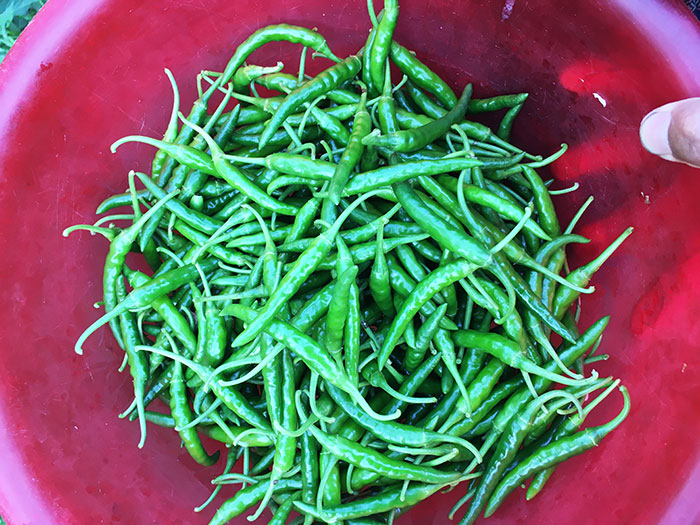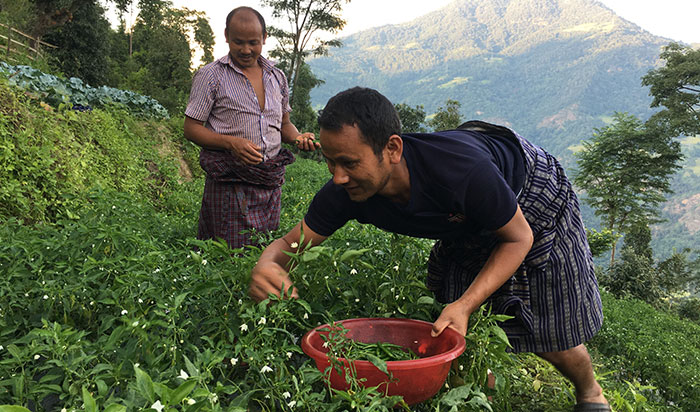Dagana agriculture sector focuses on growing four vegetable crops this fiscal year
Chimi Dema | Dagana
Realising the enormous demand for chillies, 48 farmers from lower Tsendagang chiwog, Dagana cultivated winter chilli this year. Two brothers are the first to harvest the crop.
Their village, located within 15kms from the gewog center in Tsendagang chiwog, yields terraces filled with green chillies.
Nima Dorji Waiba and his brother, Tul Bahadur Waiba raised the nursery a month earlier than the usual time and as a result, they could harvest green chillies by mid- October. The brothers grew chilli on one and half-acres land altogether.
To avoid producing excess production at a time, the plantation was done in staggered method, meaning chilli seedlings were transplanted twice, one in August and the other in December.
Normally, the nurseries for an initial staggering are raised in July and transplantation begins in August, while the harvest becomes ready only towards the end of November.
Tul Bdr Waiba has sold around 20 kilograms.
With some plants fruiting at the moment, he said he is expecting to sell more than 100kg this season. “Last year, I could harvest about 300kg from 15-decimal land.”
Tul Bahadur said that there is no problem with selling it today. “The price is good and we could sell both at the field and the nearest market in Dagapela,” he said.
A kg of chilli is sold at Nu 280.
Nima Dorji Waiba sold about 120kg so far from the 50-decimal land. This earned him Nu 30,000.
Last year, he grew chilli on about 20-decimal land and produced about 550kg. He earned Nu 150,000.

Freshly harvested chillies
“This season, I have grown more and invested most of my time in chilli cultivation. I’m expecting to harvest another 400kg,” he said.
The farmers said the nursery preparation for the second is underway. They are planning to grow on one and half-acres land in December.
Given the altitude ranging from 600 to 1,250 metres above sea level, the gewog agriculture extension officer, Bikash Tamang said many farmers in the chiwog grow chillies in December.
“It was only about four years ago that we started growing green chillies in June on trial,” he said. “It has been a success although the yield wasn’t as much as in low-lying chiwogs.”
Besides lower Tsendagang, villagers in Samerchhu chiwog are also growing chillies on seven acres.
As part of the winter vegetable programme, the gewog is also focusing on growing tomato, onion and cauliflower.
As a focused crop in Gangzor Maed and lower Tsendagang, onion is grown on about 32-acre land of 52 households. About 25 households in the chiwogs also grow tomatoes on eight-acre land.
The dzongkhag agriculture sector supported farmers with poly-house, drip irrigation and plastic mulching, among others.
Meanwhile, 967 households in Dagana are cultivating cauliflower, tomato, onion and chilli as agriculture sector prioritised crops this financial year.
The Assistant Dzongkhag Agriculture Officer, Kinley Namgay said that to make it easier for suppliers, each gewog focuses on producing one of the four vegetables depending on the altitude and climatic conditions of the area.
Of about 207 acres identified to grow cauliflower, Gozhi gewog grows on 55-acre land followed by Tsangkha on about 24 acres.
Lhamoidzingkha would grow chilli on a 40-acre land. About 225-acre land was identified for growing chillies in Dagana.
While Tsendagang focuses on growing onion on an about 32-acre land, Nichula focuses on tomato production.
Kinley Namgay said that besides focused crops, farmers in respective gewogs also grow other vegetables for self consumption.
There are 236 households growing tomato, 141 growing onion, 329 growing chillies and 261 focusing on cauliflower in 14 gewogs.


